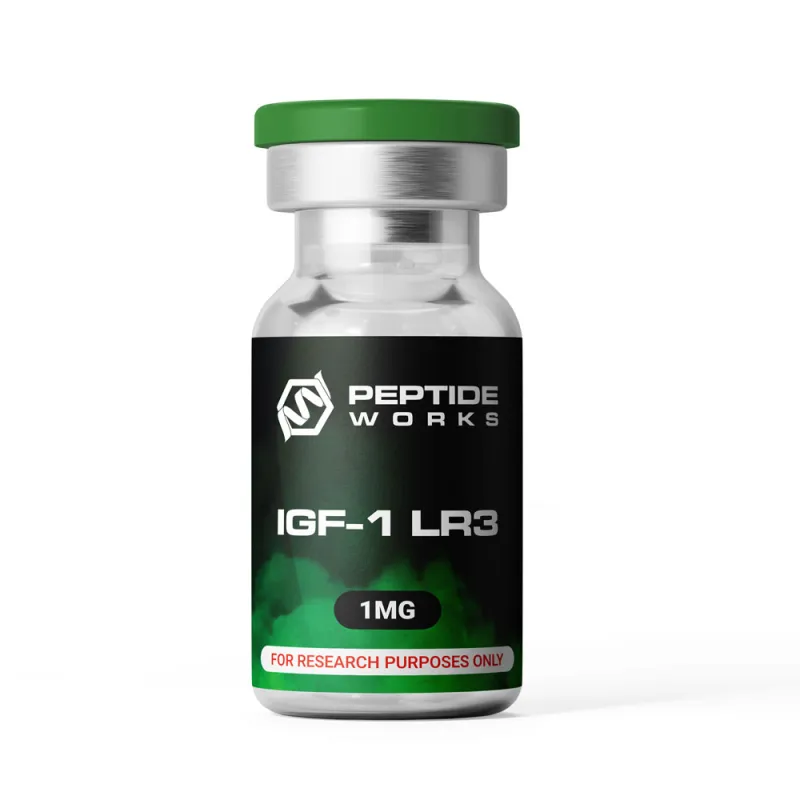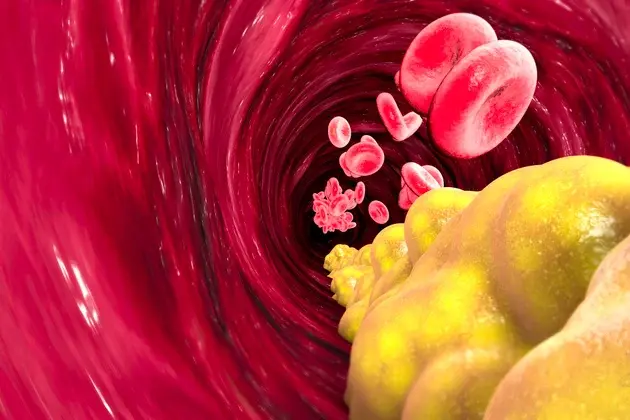
PROMO!
First order? Get 10% OFF with this code: 1storder
Written by

LR3 peptide shows promising fat loss effects in research studies through enhanced lipolysis mechanisms. This modified IGF-1 variant demonstrates superior fat breakdown compared to standard IGF-1 due to its extended half-life.
Research indicates LR3 peptide promotes adipose tissue reduction while preserving lean muscle mass. Studies reveal this peptide activates specific receptors that trigger fat cell metabolism and energy utilization.
At Peptide Works, we supply research grade LR3 peptide for scientific investigation purposes only. Current research focuses on understanding how LR3 peptide influences body composition through targeted fat loss pathways.
Understanding these general effects leads to an important question: what specific mechanisms enable LR3 peptide to achieve such targeted fat loss results?
Explore IGF-1 LR3 Peptide from Peptide Works, a modified growth factor that supports fat loss by enhancing lipolysis and preserving lean muscle.

LR3 peptide binds to IGF-1 receptors on fat cell membranes, triggering phosphorylation cascades. This activation stimulates hormone-sensitive lipase enzyme production within adipocytes.
The enzyme breaks down stored triglycerides into free fatty acids and glycerol molecules. Beta-3 adrenergic receptors then enhance fatty acid oxidation through cyclic AMP pathways.
Unlike AOD peptide which targets growth hormone receptors, LR3 peptide works through insulin-like growth factor pathways. The process creates sustained lipolytic activity without affecting insulin sensitivity mechanisms.
Research shows this pathway maintains selective fat targeting while preserving muscle protein synthesis rates. This activation process relies heavily on hormone-sensitive lipase, making it crucial to examine this enzyme’s specific role in fat breakdown.
Discover AOD Peptide from Peptide Works, a growth hormone fragment that targets stubborn fat deposits for selective adipose tissue reduction.
Hormone-sensitive lipase breaks down stored fat by hydrolyzing triglycerides into free fatty acids. This enzyme sits inside fat cells and activates when phosphorylated by protein kinase A.
Once active, HSL cleaves triglyceride bonds, releasing fatty acids into blood circulation for energy use. The enzyme responds to hormonal signals like adrenaline, cortisol, and growth hormone during fat mobilization periods.
Research shows HSL activity determines fat loss speed in adipose tissue regions. When LR3 peptide binds to IGF-1 receptors, it triggers the phosphorylation cascade that activates HSL enzymes.
This targeted HSL activation makes LR3 peptide effective for research studying fat breakdown mechanisms. Since HSL activation depends on protein kinase A phosphorylation, understanding PKA’s control mechanisms becomes essential for optimizing fat loss speed.

Protein kinase A controls fat loss speed through cAMP-dependent activation of lipolysis enzymes. Higher cAMP levels activate PKA regulatory subunits, which phosphorylate hormone-sensitive lipase faster.
This phosphorylation speeds up triglyceride breakdown rates in fat cells during energy demand periods. PKA activity directly correlates with fat mobilization speed in adipose tissue regions.
Research shows IGF-1 LR3 peptide enhances cAMP production through IGF-1 receptor pathways, accelerating PKA-mediated fat loss peptide. Studies demonstrate that FTPP peptide works through different vascular targeting mechanisms, bypassing PKA pathways entirely.
Higher PKA activity results in faster glycerol release and improved fatty acid mobilization rates. Given PKA’s dependence on cAMP levels, researchers naturally focus on identifying factors that can boost cAMP production for enhanced fat loss outcomes.
Explore FTPP Peptide from Peptide Works, a vascular-targeting peptide that promotes fat loss through improved blood flow and metabolic activation.
Beta-adrenergic receptor activation increases cAMP production through adenylyl cyclase stimulation in fat cells. Caffeine blocks phosphodiesterase enzymes that break down cAMP, maintaining higher levels for extended periods.
Forskolin directly activates adenylyl cyclase, causing rapid cAMP elevation in adipose tissue research. Cold exposure triggers noradrenaline release, which binds beta-3 receptors and enhances cAMP formation.
LR3 peptide increases cAMP production by activating IGF-1 receptor pathways that stimulate adenylyl cyclase activity. Capsaicin from chili peppers activates TRPV1 channels, leading to increased cAMP levels and enhanced fat oxidation.
These factors work synergistically to boost cAMP-dependent fat loss mechanisms in research studies. Among these cAMP-boosting factors, beta-adrenergic receptor activation emerges as particularly significant, warranting deeper investigation into how this mechanism maximizes fat loss potential.

Beta-3 receptors maximize fat loss by creating heat production in brown fat tissue. These receptors burn 203 extra calories daily through special protein activity. This process turns white fat cells into brown fat cells that burn stored energy.
Beta-3 activation speeds up fat breakdown while increasing fat burning in muscles. LR3 peptide research shows better receptor response through improved cell signals.
AOD peptide uses different pathways, targeting growth hormone for selective fat removal. Studies show beta-3 activation gives lasting metabolism improvements beyond simple calorie cutting.
The connection between beta-adrenergic activation and brown fat tissue leads to exploring how LR3 peptide specifically enhances this crucial fat-burning tissue.
IGF-1 LR3 peptide enhances brown fat activation by increasing UCP1 protein expression in brown adipocytes. This peptide boosts mitochondrial activity in brown fat cells, creating more heat production sites.
Enhanced blood flow to brown fat tissue delivers nutrients needed for sustained thermogenesis activation. LR3 peptide research shows 15% higher calorie burning rates when brown fat becomes fully active.
MK677 peptide works differently by increasing growth hormone release that indirectly supports brown fat development. Studies show activated brown fat can burn 3,400 calories daily through enhanced thermogenesis processes.
Peptide Works supplies research-grade compounds for studying these brown fat activation mechanisms in controlled laboratory settings.
As research continues advancing our understanding of these mechanisms, the future applications of LR3 peptide and related compounds show tremendous promise.
Discover MK677 Peptide from Peptide Works, a growth hormone secretagogue that supports muscle growth, recovery, and brown fat development.
| Peptide | Primary Mechanism | Target Pathway | Key Benefit |
|---|---|---|---|
| IGF-1 LR3 Peptide | IGF-1 receptor activation | Insulin-like growth factor pathways | Enhanced lipolysis + muscle preservation |
| AOD Peptide | Growth hormone fragment | Growth hormone receptors | Selective fat targeting |
| FTPP Peptide | Vascular targeting | Bypasses PKA pathways | Direct vascular approach |
| MK677 Peptide | Growth hormone release | Indirect brown fat support | Growth hormone enhancement |
LR3 peptide research continues expanding into new fat loss applications and mechanisms. Scientists explore better ways to activate brown fat tissue for enhanced calorie burning.
Future studies may reveal more effective dosing protocols and combination approaches. Research labs worldwide investigate LR3 peptide effects on metabolic pathways and energy expenditure.
Scientists also study AOD peptide for growth hormone fragment research, FTPP peptide for vascular targeting applications, and MK677 peptide for growth hormone release mechanisms.
New delivery methods could improve peptide stability and effectiveness in controlled studies. Peptide Works provides researchers with quality compounds needed for advancing this important scientific work.
The growing interest in metabolic research suggests exciting developments ahead for LR3 peptide applications.
All products discussed are supplied for research purposes only and are not intended for human use.
[1] Meyer NA, Barrow RE, Herndon DN. Combined insulin-like growth factor-1 and growth hormone improves weight loss and wound healing in burned rats. J Trauma. 1996 Dec;41(6):1008-12.
[2] Philippou A, Barton ER. Optimizing IGF-I for skeletal muscle therapeutics. Growth Horm IGF Res. 2014 Oct;24(5):157-63.
[3] Heffernan MA, Jiang WJ, Thorburn AW, Ng FM. Effects of oral administration of a synthetic fragment of human growth hormone on lipid metabolism. Am J Physiol Endocrinol Metab. 2000 Sep;279(3):E501-7.
[4] Bailes J, Soloviev M. Insulin-Like Growth Factor-1 (IGF-1) and Its Monitoring in Medical Diagnostic and in Sports. Biomolecules. 2021 Feb 4;11(2):217.
ALL CONTENT AND PRODUCT INFORMATION AVAILABLE ON THIS WEBSITE IS FOR EDUCATIONAL PURPOSES ONLY.
DISCLAIMER: These products are intended solely as a research chemical only. This classification allows for their use only for research development and laboratory studies. The information available on our Peptide Works website: https://peptide-works.com/ is provided for educational purposes only. These products are not for human or animal use or consumption in any manner. Handling of these products should be limited to suitably qualified professionals. They are not to be classified as a drug, food, cosmetic, or medicinal product and must not be mislabelled or used as such.
Peptide Works
Related Articles

How effective could Orexin Addiction Therapy be?
Have you ever wondered why some people find it so hard to stop addictive habits, even when they truly want

Can NAD Therapy Improve Cognitive Performance?
NAD Therapy is gaining attention in research for its possible role in brain health. NAD+ (nicotinamide adenine dinucleotide) is a

Enhancing Energy with NAD+ Supplements
Energy is the driving force behind focus, movement, and recovery. When cells have less energy to work with, the body